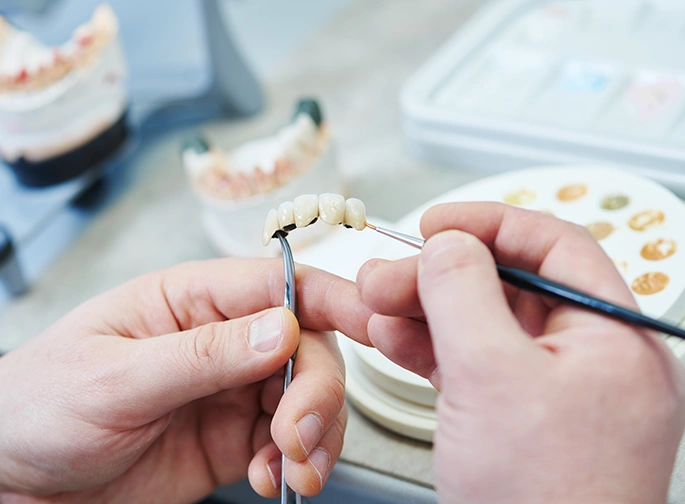
Dental Implants London
Dr Clarke, trained with a specialist Implantologist, uses the Bicon system. This implant procedure is often preferred for replacing missing teeth, as no other teeth need to be involved. The implant, made of titanium, takes the place of the root of your tooth. In a simple surgical procedure, the titanium implant is placed in to your jaw and during the healing phase, usually uneventful, the bone of your jaw grows together with the implant, a process known as “osseointegration”.This process is complete after three to four months, when a tooth can then be fitted to the implant.
Implants – FAQ
Q1. Are dental implants safe and how long will they last?
Implants are a well-established, tried-and-tested treatment. Our preferred Bicon system is achieving a 96% success rate. With the right care, all modern implants should last for many years.
Q2. I have some of my own teeth, can I still have implants?
Yes. You can have any number of teeth replaced with implants – from one single tooth to a complete set.
Q3. Can implants always be used to replace a missing tooth?
It depends on the state of the bone in your jaw. If there is not enough, or if it isn’t healthy enough, it may not be possible to place implants. Though in many cases where your bone is not ideal, an initial procedure to build up the bone of your jaw is nearly always possible. This will add about four months to the length of treatment, to allow for the additional healing.
Q4. Are Implants uncomfortable?
Placing the implants requires a small operation. This can be done using a simple local anaesthetic. You may feel some discomfort during the week after the surgery. This is usually due to having stitches and the normal healing process. Once in function, the implant and the implant tooth are just like your own teeth.
Q5. How long does the treatment take?
We’ll be able to give you a rough timetable before the treatment starts. Usually the implants can be placed three to four months after the loss of your teeth; the teeth are fixed three to four months after the implants are placed. If cosmetically required, or if you are having several teeth replaced, a temporary bridge or denture can be made. If you already have a denture, then this can be worn throughout the healing period once modified after the surgery.
Q6. Does the implant show?
Your dentist will make sure that the implants won’t show during all normal movements of the mouth and lips. You will need to be able to see them, so that you can clean them properly.
Q7. Do I have an implant for each missing tooth?
This depends on the number of teeth missing and the implant system used for replacement
Q8. What happen if the implant does not bond together with the bone?
This happens very rarely. If the implant becomes loose during the healing period or just after, then it is easily removed and bone healing takes place in the normal way. Once the jaw has healed, another implant can be placed, or plans can be changed and a bridge made, using the implants that have ‘taken’ or preparing your own teeth for crowns.
Bridges
These have been the standard replacements for missing teeth for over forty years. Using the correct materials and procedures, quite a large space can often be replaced with a bridge. Crowns are prepared on the teeth acting as supports, these are then linked together with the crowns made to replace the missing teeth. The whole bridge, a one piece construction, is then cemented in to place on the supporting teeth, filling the space with fixed teeth.
We often prefer a bridge to replace a missing tooth, especially when the teeth either side of the space also need crowns for a satisfactory long term restorative result.
Wherever possible, we make our bridges out of pure ceramic (porcelain). Without any metal base and with modern advances in ceramic technology, they reflect and refract light similarly to tooth enamel and dentine, thus giving a very natural appearance. With the matching tooth shade taken and without lines around the crowns at the gum margins, the bridges are usually indistinguishable from the surrounding teeth.

In some situations, a metal base to the bridge is required, this then has porcelain teeth fashioned and bonded to the metal base, producing a very lifelike result.
Advantages over implants:
- No invasive surgery required
- A completed result can be obtained much sooner
Possible disadvantages:
Adjacent teeth have to be prepared for the crown supports, which we’d prefer to avoid if these teeth are previously untouched, though can be advantageous if the adjacent teeth are already heavily restored.
Implants are a well-established, tried-and-tested treatment. Our preferred Bicon system is achieving a 96% success rate. With the right care, all modern implants should last for many years.
- Monday 09:00AM - 08:00PM
- Tuesday 09:00AM - 08:00PM
- Wednesday 09:00AM - 08:00PM
- Thursday 09:00AM - 08:00PM
- Friday 09:00AM - 08:00PM
- Saturday 09:00AM - 08:00PM
- Sunday 09:00AM - 04:00PM






